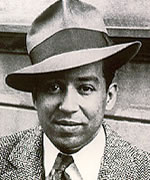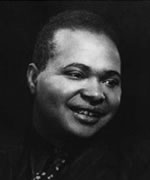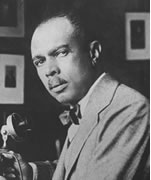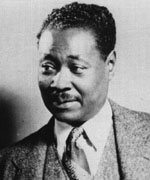Zora Neale Hurston (1891-1960)

Zora Neale Hurston was unlike any other successful African American from the Harlem Renaissance. Hurston was doing fine on her own and did not come to Harlem until some friends of hers urged her too. Even then, she did not come for success. However, success found her at Harlem. She met many people in Harlem that inspired and urged her to follow her talent to it’s peak. She took their advice and attempted to start a career as a poet and a writer. However, Hurston never made a living off of poetry and had to take a job as a maid in New York City to make enough money to support herself. Many people in that time blamed her working under a white man on her color and pitied her but Hurston never felt this way. In her essay “How It Feels to Be Colored Me” she wrote “I have seen that the world is to the strong regardless of a little pigmentation more or less. No, I do not weep at the world—I am too busy sharpening my oyster knife."
Langston Hughes (1902-1967)

Langston Hughes was a well known poet of the Harlem Renaissance but he was also a playwright, an essayist and even wrote an opera. His style of writing was different than anyone had ever seen much less written. He took the very essence of Harlem and weaved it into his poems creating Harlem on paper. He took Jazz and the Blues and put their beat and rhythm into the music so that you could hear and feel Harlem with every word. He wrote of the energy in Harlem and you could almost feel the business and excitement. His poetry was the greatest they had seen and he was the first African American to make a living solely off of writing so they named Hughes “Poet Laureate of Harlem”. Hughes writing is still well known today and still has a touch of what Harlem used to be today.
I, Too
I, too, sing America.
I am the darker brother.
They send me to eat in the kitchen
When company comes,
But I laugh,
And eat well,
And grow strong.
Tomorrow,
I'll be at the table
When company comes.
Nobody'll dare
Say to me,
"Eat in the kitchen,"
Then.
Besides,
They'll see how beautiful I am
And be ashamed--
I, too, am America.
I, too, sing America.
I am the darker brother.
They send me to eat in the kitchen
When company comes,
But I laugh,
And eat well,
And grow strong.
Tomorrow,
I'll be at the table
When company comes.
Nobody'll dare
Say to me,
"Eat in the kitchen,"
Then.
Besides,
They'll see how beautiful I am
And be ashamed--
I, too, am America.
Countee Cullen (1903-1946)

Countee Cullen was one of the many poets whose works were remembered long after his time. He was not a very social person- no one knew much about him and he wasn’t known to talk much about his past. His poems were his way of expressing his views on life and it seems that nothing else mattered very much to him. Most of his poems talked of their unfair society where one race was better than another and racism or his past experiences. His first collection of poems came about in 1925 and they were named COLOR which was about the beauty of being a colored person and the effects and awfulness of racism. I thought this was fitting. He’d been discriminated against as an African American and I think that was what he had on his mind as he wrote this. Though no one knew much about him except what he had written in his poems, he was an inspiration to African Americans everywhere.
Incident
Once riding in old Baltimore,
Heart-filled, head-filled with glee;
I saw a Baltimorean
Keep looking straight at me.
Now I was eight and very small,
And he was no whit bigger,
And so I smiled, but he poked out
His tongue, and called me, "Nigger."
I saw the whole of Balimore
From May until December;
Of all the things that happened there
That's all that I remember.
Once riding in old Baltimore,
Heart-filled, head-filled with glee;
I saw a Baltimorean
Keep looking straight at me.
Now I was eight and very small,
And he was no whit bigger,
And so I smiled, but he poked out
His tongue, and called me, "Nigger."
I saw the whole of Balimore
From May until December;
Of all the things that happened there
That's all that I remember.
James Weldon Johnson (1871-1938)

James Weldon Johnson was a poet and a novelist. He was a playwright and a civil rights leader. He was a public speaker and an advocate of the Harlem Renaissance. Johnson was one of the most involved people in the Harlem Renaissance. He was said to be the beginning of the Harlem Renaissance, Harlem before it was Harlem. His novels and poems were perhaps the most effective because people heeded his advise. He was a strong believer in African American pride and heritage and expressed this in his novel, The Book of American Negro Poetry which some people believe was the start of the Harlem Renaissance. Johnson realized that the African Americans were not going to get the economic power they deserved anytime soon and spread word of that. But he maintained that they should all reach for their dreams like he did, become a part of society and slowly break down the wall between White and Black. People look back at the Harlem Renaissance now and realize all that he did for society and he remains an inspiration to all.
Claude McKay (1889-1948)

Claude McKay again was someone who did not know what he truly wanted to do when he came to Harlem. He came to study agriculture but instead found he had a talent with words and became a poet and a novelist. McKay’s most famous novel was “Home to Harlem” which was about a soldier coming home to Harlem after World War II. McKay wrote many other poems and novels where he told of how racism and segregation infuriated him and was disappointed by black editors who he felt took out or changed vital lines. The final straw was when he met W.E.B. Du Bois who he had looked up to and written poems based on his lectures and discovered he was a cold person. He then quit his writing for a while but later came back with stories of his life, though his work was never the same. Nevertheless he was a great writer in the Harlem Rennaissance and is remembered to this day as such.
Adolescence
There was a time when in late afternoon
The four-o'clocks would fold up at day's close
Pink-white in prayer, and 'neath the floating moon
I lay with them in calm and sweet repose.
And in the open spaces I could sleep,
Half-naked to the shining worlds above;
Peace came with sleep and sleep was long and deep,
Gained without effort, sweet like early love.
But now no balm--nor drug nor weed nor wine--
Can bring true rest to cool my body's fever,
Nor sweeten in my mouth the acid brine,
That salts my choicest drink and will forever.
There was a time when in late afternoon
The four-o'clocks would fold up at day's close
Pink-white in prayer, and 'neath the floating moon
I lay with them in calm and sweet repose.
And in the open spaces I could sleep,
Half-naked to the shining worlds above;
Peace came with sleep and sleep was long and deep,
Gained without effort, sweet like early love.
But now no balm--nor drug nor weed nor wine--
Can bring true rest to cool my body's fever,
Nor sweeten in my mouth the acid brine,
That salts my choicest drink and will forever.
